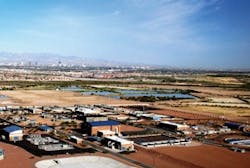Mysterious Missing VFA & Bio-P
The Kurt R. Segler Water Reclamation Facility (WRF), located in Henderson, Nev., treats an average flow of 21.5 million gal per day. Effluent is discharged to the Las Vegas Wash and then into Lake Mead. Regulatory requirements result in maximum permissible effluent total phosphorus concentrations of 0.14 mg/L at design flow and load.
In 2005, the city engaged Black & Veatch to add a phosphorus removal capability to the existing Carrousel (channel-type) treatment plant. Sampling and modeling performed as part of the design indicated the presence of sufficient volatile fatty acid (VFA) concentrations to effectively remove phosphorus by converting the existing treatment plant into a biological nutrient removal (BNR) train and adding another BNR process train. The project team added aeration to the existing channels, created anaerobic and anoxic zones, and added a second BNR train. Construction of the new facilities would enable the city to meet strict nitrogen and phosphorus discharge limits through nitrification and denitrification. Biological phosphorus (Bio-P) was on its way to Henderson. Or was it?
Upon startup of the new facilities, the WRF could not meet its phosphorus removal goals. An investigation revealed a VFA concentration of less than 15 mg/L in the influent. So what had changed during construction of the new facilities?
Not So Elementary
Several of the local casinos had a wastewater odor issue that was outside the city’s realm of responsibility. The casinos fixed the problem by adding a nitrate compound to the sewer for odor control. The project team discovered that the casinos’ response to the odor problem inadvertently created a problem for city operations by changing the WRF influent characteristics such that there were not enough soluble readily biodegradable organic carbon compounds (rbCOD). The reduction in the rbCOD concentration deprived the Bio-P process of the necessary rbCOD-to-phosphorus ratio to make the process work as it should. Fermentation was needed somewhere in the system to make the rbCOD and VFA that
phosphorus-accumulating organisms (PAOs) need for effective phosphorus removal.
The WRF does not have primary clarifiers, but does have backup chemical polishing and effluent filters. The nitrate compound was stopping fermentation in the sewer, but fermentation was necessary somewhere within Henderson’s system to create sufficient VFA concentrations. To encourage solids to settle, thicken and begin to ferment, the project team proposed periodically shutting off the mixer in one of three cells of the anaerobic zone in both BNR trains to allow sludge to settle. Mixed liquor continues to flow, floating over the denser thickened sludge and enabling an exchange of the mixed liquor and VFA that form in the settled sludge.
Solving the Mystery
In Henderson, operating the mixer for 20 minutes per day prevents permanent settling of solids in the tank and encourages an exchange between the top and bottom layers of fresh sludge and VFA-rich fermented sludge. The mixing time is not sufficient to wash out all the solids, but the mixed liquor is still denser than the incoming mixed liquor suspended solids, even after the mixing stops. Shortly after each mixing cycle ends, the sludge settles again. The fermentation yields sufficient rbCOD/VFA to allow Bio-P to perform well and minimizes the amount of chemical polishing needed to meet the strict permit limit.
Fermentation of the mixed liquor seems counter-intuitive, but it appears that the PAOs survive during fermentation when there is an abundance of VFA. It is postulated that PAOs take up the formed VFA, release phosphorus and then wait for an opportunity to metabolize the hoarded food in the presence of dissolved oxygen. The other heterotrophic organisms do not have the ability to store food, so some die and are fermented together with adsorbed particulate matter from the influent. This produces the necessary VFA for the PAOs to survive, as well as surplus VFA for the PAOs that floated over the top of the sludge blanket. When the PAOs get to the aeration zone, they metabolize the stored food to obtain the energy to restore their phosphorus pool, removing the phosphorus from the liquid stream.
The secondary effluent was further treated in the tertiary stage by addition of alum for removal of the residual orthophosphates and coagulation and removal of the particulate phosphorus in the sand filters.
The average influent biochemical oxygen demand (BOD) at the WRF is 255 mg/L. Total Kjehldahl nitrogen (TKN)—the combination of organically bound nitrogen and ammonia—and total phosphorus are 42 and 5.5 mg/L, respectively. The BOD/total phosphorus ratio normally is higher than 40, which is favorable for enhanced biological phosphorus removal (EBPR).
Even though the plant had the standard anaerobic zone design for phosphorus removal, some rbCOD (soluble BOD) in the feed is essential for EBPR. At the relatively higher oxidation reduction potential in standard mixed anaerobic zones, only rbCOD (soluble BOD) can be fermented to VFA, and deeper anaerobic conditions are required for fermenting some of the slower degradable carbon compounds to VFA. Such conditions can be achieved by fermenting some mixed liquor by settling solids and increasing the solids retention time in the anaerobic zone.
Two valuable lessons can be gleaned from this case study. One is that collection system activities can adversely impact BNR performance, especially Bio-P. The second is that there are various fermentation approaches if influent wastewater needs more rbCOD to make Bio-P work well. Fermentation is the key to success for Bio-P removal, and if it does not happen in the collection system, it can be made to happen within the BNR process.
Download: Here
